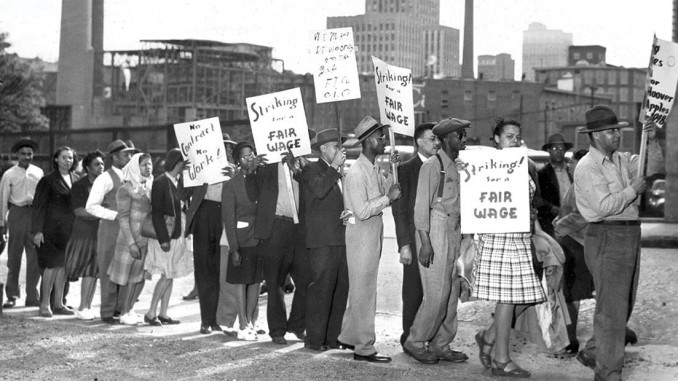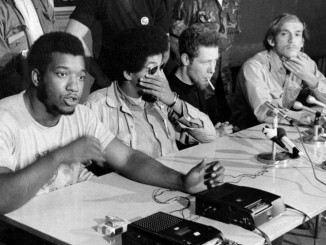
In 1940s North Carolina, the racist system called “Jim Crow” oppressed every aspect of Black lives. Segregation and discrimination were enforced by racist courts and police, and by the violence of organizations like the KKK.
Jim Crow also ruled North Carolina’s factories, keeping unions out and workers down, white as well as Black. Black workers, male and female, in cities and also in rural districts generally received poverty wages, and always less than whites. Black factory workers were only hired for the hardest and lowest-paying jobs.
That was the reality at RJ Reynolds massive cigarette factory in Winston-Salem. The factory employed nearly 10,000 workers, making it the city’s largest employer. About two-thirds of them were Black, and mostly women. By 1943 factories were booming thanks to the stimulus from World War II. With increased demand came pressure to produce more cigarettes in less time. In May of 1943 RJ Reynolds management raised production quotas, which meant most workers experienced an unsustainable speedup. Foremen kept the pressure on, with the Black workers frequently experiencing racist abuse.
During the week of June 17-23, the workers at the plant in Winston-Salem, mostly Black women, organized a successful sit-down strike to protest overwork and abuse. The sit-down began in one department, Department 65, but within a few days the whole plant of 10,000 workers shut down. The strikers received tremendous community support from the Black neighborhoods. Their movement extracted concessions on wages and working conditions the Jim Crow bosses never expected to have to make, including having to recognize a union – the Food, Tobacco, Agricultural, and Allied Workers Union (FTA)!
Theodosia Simpson remembered exactly how the confrontation that set off the strike began on the hot muggy morning of June 17.
“The lady who worked on the machine next to me, she was a widow with five kids, and she was sick that day. Oh, you could get sick up there in a minute, the way you had to work. She couldn’t keep up with her work. Other workers would often pick up the slack when one of their number fell behind, but she didn’t have too good a relationship with the other two people on the machine, so they weren’t helping her. The foreman came up and told her that if she didn’t catch up, ‘there was the door that the carpenter left.’ She started crying because she had these children to rear and nobody working but her. And that sort of got next to me. I called a couple of people I thought I could trust ‘down house,’ down to the lavatory. I said, ‘When we come in here tomorrow, let’s not work until we get some understanding on how these people are going to be treated.’”
Theodosia Simpson could take the initiative in the confrontation because she knew there were like-minded people in the plant she could trust. She was one of a small group of workers who had been meeting quietly for almost a year to talk about the conditions and what could be done to change them. These meetings gave its participants confidence that they were not alone. Members of this informal network also met with union organizers from the recently formed Food, Tobacco, Agricultural, and Allied Workers of America (FTA), a militant union committed to racial equality. These activities prepared participants in the in-plant network to take the initiative when their fellow workers showed they were ready to take a stand.
Sister Simpson then left her workstation in Department 65 to ask for support from a group of Black men who worked in an adjacent room packing cases of partly processed tobacco. They agreed. Just before the lunch break a foreman who had gotten wind of their plan began to lecture the women that they would lose their jobs if they refused to work the next day. The threats backfired; talking on their lunch break, the women decided not to start work again when their break ended. They stood with their backs to the idle machines.
“The foreman looked at us as if we were crazy,” another striker, Geneva McClendon remembered. “He pulled the whistle again and nobody moved. He asked what was wrong. Several of us told him that we weren’t going to work until our working conditions were improved, our workload cut to where we could get our work out, and we wanted our wages equalized. The foreman said he couldn’t do nothing and if we didn’t want to work to get out. We told him we wanted to work but not under those conditions and if he couldn’t do nothing we would like to talk to the person that did have the authority to remedy the situation.”
At that moment, the conflict took a dramatic turn. James McCardell, a thirty-eight-year-old “draft boy” who had worked for fifteen years putting boxes of tobacco on the women’s machines, stepped forward to make it clear to the foreman that the men from the casing room were going to back the women’s refusal to work.
“If these women’ll stand up for their rights, I’m with them,” he proclaimed. No sooner had the words left McCardell’s mouth than he crashed to the floor. The few machines that were still running stopped as everyone rushed to see what was wrong. “Some fellows grabbed him and carried him to the nurse,” Simpson recalled. “One came back and said, ‘He’s already dead.’ He had been sick that whole week, going back and forth to the nurse. Instead of staying home, he would come to work and feel bad. He would go to the nurse, but she said he wasn’t sick and sent him back to the floor to work”. Quickly word spread. By the middle of the afternoon, about 150 workers in other departments had stopped their machines and were sitting in. Plant manager Whitaker agreed to meet with a committee of the workers the next day and hear their proposed agreement.
That evening a group of about 50 workers, mostly strikers but also network members from other departments met in a church to decide on their demands. They also decided to urge all RJ Reynolds workers to report for work the next day but refuse to work until their grievances were satisfied. Meanwhile, Black Winston-Salem was abuzz discussing what had happened in Department 65. Almost everyone in town had either worked or were working at RJ Reynolds, or knew somebody who did. Community support began to solidify.
Friday morning, when the factory whistle blew, 1,600 Black women workers in two departments refused to turn on their machines. Plant boss John Whitaker responded that there would be no discussion of grievances until everyone had resumed working. At that point, strike leaders spread out in the plant and successfully persuaded the departments still working to shut down. By the middle of the afternoon, production has stopped completely. Strikers visited between departments. When the workers left the plant at the end of their shifts, union organizers at the gates signed up hundreds.
On Saturday, James McCardell was buried. On Sunday, more than 10,000 workers converged on the Woodland Avenue School grounds for a mass meeting. They voted not to return to work without a legally binding agreement that no strikers would be fired.
On Monday, the entire plant remained shut down. None of the workers massed at the plant entered the gates. That same morning, workers at the Mengel Box Company, which supplied the tobacco industry, walked out. Black workers at Hanes Knitting Company joined the strike, as did maids at the Robert E. Lee Hotel. On Tuesday, Whitaker signed the agreement, and the workers voted to return to work.
Negotiations with the company stalled for months. However, pressure from the union rank and file, including shop floor struggles to limit the authority of foremen, eventually forced RJ Reynolds to sign a formal contract. It included wage increases, promotions based on seniority, a grievance procedure that was a tool to rein in shop floor abuse by foremen, and a host of quality-of-life improvements — including better bathroom facilities and rain tarps to protect workers riding in trucks.
By the time the contract was signed, nearly all the Black workers had joined the union, FTA Local 22. Some whites who saw the benefit of being unionized also joined. The officers of the local were the Black women and men who stood up to the company in the first days of the struggle. The mass actions which won a union at RJ Reynolds spurred on union organizing efforts at other cigarette factories as well as other rural tobacco warehouses and farms throughout the middle of North Carolina.
Both the leaders and members of Local 22 had goals that went beyond winning improvements on the job. They saw that the union’s power built through mass participation and action would be a force in the struggle against Jim Crow in the larger society. This power of organized Black workers in the struggle against Jim Crow was inherently a challenge to the traditional Black middle class leadership of clergymen and business men whose conception of struggle was limited to sponsoring law suits
In the next few years, Local 22 mobilized this power to improve many aspects of life in Winston-Salem. Housing for low-paid workers in Winston-Salem was poor and overpriced. Local 22 led a campaign against slum housing, successfully pressuring the city to build 1200 rental housing units. Local 22 also demanded the city put these homes under rent control so workers could afford the new housing.
Beginning in 1945, Local 22 leaders and members repeatedly rallied at the courthouse demanding to be registered to vote. They demanded registrars come into the community on evenings and Saturdays. This mass pressure forced the white supremacist Democratic Party to allow hundreds of working-class Blacks to register for the first time. In 1947, Local 22 spearheaded the election campaign of the Rev. Kenneth R. Williams — a much-respected community figure — as alderman. Based on the success of Local 22’s efforts to force Winston Salem to let Black people vote, Williams became the first Black candidate to defeat a white rival in a Southern city in the 20th century. Over the next two years, FTA locals had similar successes in other towns in the upper south.
These struggles by Black North Carolina workers showed how Jim Crow could be beaten back. It showed there was a militant alternative to the leadership of the Black middle class whose opposition to Jim Crow was limited to filing lawsuits. Some workers and leaders of Local 22 began to join communist and socialist organizations. These workers had come to believe that organized workers could not only take on the Jim Crow system, but that they could go on to challenge the exploitation and oppression of human beings in all the forms it takes in a capitalist society.
In 1945, at the end of the Second World War, the United States was at a crossroads. Would the hundreds of thousands of Black people drafted into the army, and who had been told they had been “fighting for democracy,” decide to fight to make democracy a reality at home? Would workers organize unions to win their rights in the factories built during the war where the bosses refused to recognize their rights?
Employers both north and south geared up to keep down the possibility that workers would assert themselves at the end of the Second World War as they had in the years before it. The bosses used their control of the media, Congress, the FBI, and – in the south – the KKK to punish organizations that stood up to them. One of their prime targets was unions like the FTA, which was committed to racial equality and whose experience in fighting the bosses had convinced some of the members and leaders to become radicals and revolutionaries.
Red-baiting, the practice of smearing the boldest fighters for workers’ rights and racial justice as somehow un-American and too radical, took its toll on Local 22 activists. Over and over again Winston-Salem newspapers red-baited Local 22, naming not only leaders but individual members as conspirators having a hidden agenda to overthrow the government. FBI agents and police detectives intimidated the friends and neighbors of union members.
The final blow came in March of 1950 when the government required RJ Reynolds workers to vote on whether Local 22 should continue to represent them. Even after 4 years of constant redbaiting and other scare tactics, a narrow majority of the workers voted to keep their union. To ensure the defeat of the union, however, the government ultimately had to count the votes of workers who had quit or had become supervisors. Local 22 appealed this action, but the courts backed the company and the government. Local 22 leaders were blacklisted, meaning they were put on a list by employers that kept them from being hired anywhere in the area. Some had to leave Winston-Salem to find work and Local 22 officially went out of existence.
Nevertheless, Winston Salem’s power structure did not dare to undo all the good work the fighting members and leaders of Local 22 had accomplished over the seven years of its existence. RJ Reynolds maintained most of the improvements in working conditions the union had fought for. It continued to pay higher wages than other factories so as not to provoke the large percentage of pro-union members in its workforce. The city government didn’t try to disenfranchise the newly registered Black voters. However, they did gerrymander the council districts to disadvantage the growing Black vote.
After the defeat of Local 22, it would take a decade for Winston-Salem to experience the revival of mass protest against Jim Crow. The revival would take the form of student sit-ins at lunch counters and other public accommodations. The students who joined the sit-in movement of the 1960s had many sources of inspiration and came from various backgrounds, but in Winston-Salem, some of the first to join the new movement were the sons and daughters of members of Local 22.




